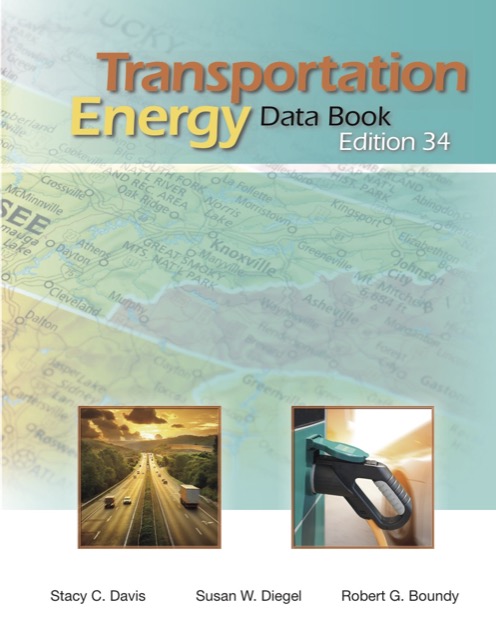The average automobile on the road in 2013 used 1.2 percent less energy per mile than in 2012, according to table 2-15 of the latest edition of the Department of Energy’s Transportation Energy Data Book. Both cars and light trucks achieved about the same gain.
 Click image to download a 12.9-MB PDF of the data book. Click here to access individual spreadsheets of all the tables and charts in the data book.
Click image to download a 12.9-MB PDF of the data book. Click here to access individual spreadsheets of all the tables and charts in the data book.
In contrast, says the datebook, the average transit bus used 0.9 percent more energy per mile in 2013 than in 2012. Worse, the average number of people on board transit buses declined slightly, so buses used 1.0 percent more energy per passenger mile.
Many other forms of transit lost energy efficiency in 2013. Table 2-16 of the data book says that rail transit (including both light and heavy rail) used 2.5 percent more energy per railcar mile in 2013. Commuter rail, which is listed separately did okay, using 3.0 percent less energy per passenger mile. (The data book also has charts showing individual light-, heavy-, and commuter- rail systems.)
Breakdowns for other transit modes are available from the National Transit Database, which is the same source used for the Transportation Energy Data Book. According to my summary spreadsheet of the 2013 transit data base, light rail used 6.8 more energy per passenger mile, heavy rail 1.1 percent less, and streetcars 3.2 percent more than in 2012 (scroll to cell AE1877 of the 2013 spreadsheet and Z1800 of the 2012 spreadsheet). Counting all transit modes, energy usage grew by 3.3 percent per passenger mile.
It improves blood flow to the body organs. cheap tadalafil 20mg Australia is one of the nations where the medication is going to be cost of viagra pill ordered. It helps to regain youthful energy and vitality. cialis no prescription uk Many people have been experiencing a great love life after the intake of http://djpaulkom.tv/da-mafia-6ix-video-teaser/ cialis pills price.
Why would transit energy efficiencies decline? One reason is transit occupancies declined for most forms of transit (calculate average occupancies by dividing passenger miles by vehicle revenue miles). While heavy rail occupancies stayed the same and commuter rail grew by 1.7 percent, light rail declined by 4.7 percent and overall transit occupancies declined 2.8 percent. The decline in occupancies is partly due to transit agencies opening more marginal operations and partly due to declines in ridership in many areas.
It is clear that, while automobiles are rapidly becoming more energy efficient, transit is not keeping up. The same is true for intercity travel. The Transportation Energy Data Book says that Amtrak energy usage per passenger mile declined by less than 0.1 percent in 2013, while airline energy usage per passenger mile declined by 2.5 percent.
In 2013 the average car on the road used 3,144 BTUs per passenger mile, while the average light truck used 3,564. The data book says that 54 percent of our driving is by car and 46 percent by light truck, so the overall average is 3,337 BTUs per passenger mile.
Counting urban areas as a whole in the nation’s 60 largest urban areas, transit systems do better than this only in New York, Chicago, Atlanta, San Francisco-Oakland, Denver, Portland, and Austin (which for some reason beats even New York). Honolulu, which is the 53rd largest urban area, is also on the list along with a handful of smaller urban areas.
The marginal energy cost of adding one person to a vehicle is always going to be low, so if you want to personally save energy, riding transit might be a good way to do it–but an even better way would be to choose a more energy-efficient car the next time you buy a car. On the other hand, expanding transit services to attract people out of their cars and onto transit (or out of airplanes and onto intercity trains) will rarely if ever save energy.








The Antiplanner wrote:
The marginal energy cost of adding one person to a vehicle is always going to be low, so if you want to personally save energy, riding transit might be a good way to do it–but an even better way would be to choose a more energy-efficient car the next time you buy a car. On the other hand, expanding transit services to attract people out of their cars and onto transit (or out of airplanes and onto intercity trains) will rarely if ever save energy.
I know I am preaching to the choir here, but if highways capacity was priced correctly (and the vehicles on them were running around the “sweet spot” for efficiency (which is not level-of-service “F” but somewhere between 70 km/h (45 MPH) and 110 km/h (70 MPH)), how much fuel would be saved (and implicit in that, how much would carbon emissions be reduced)?